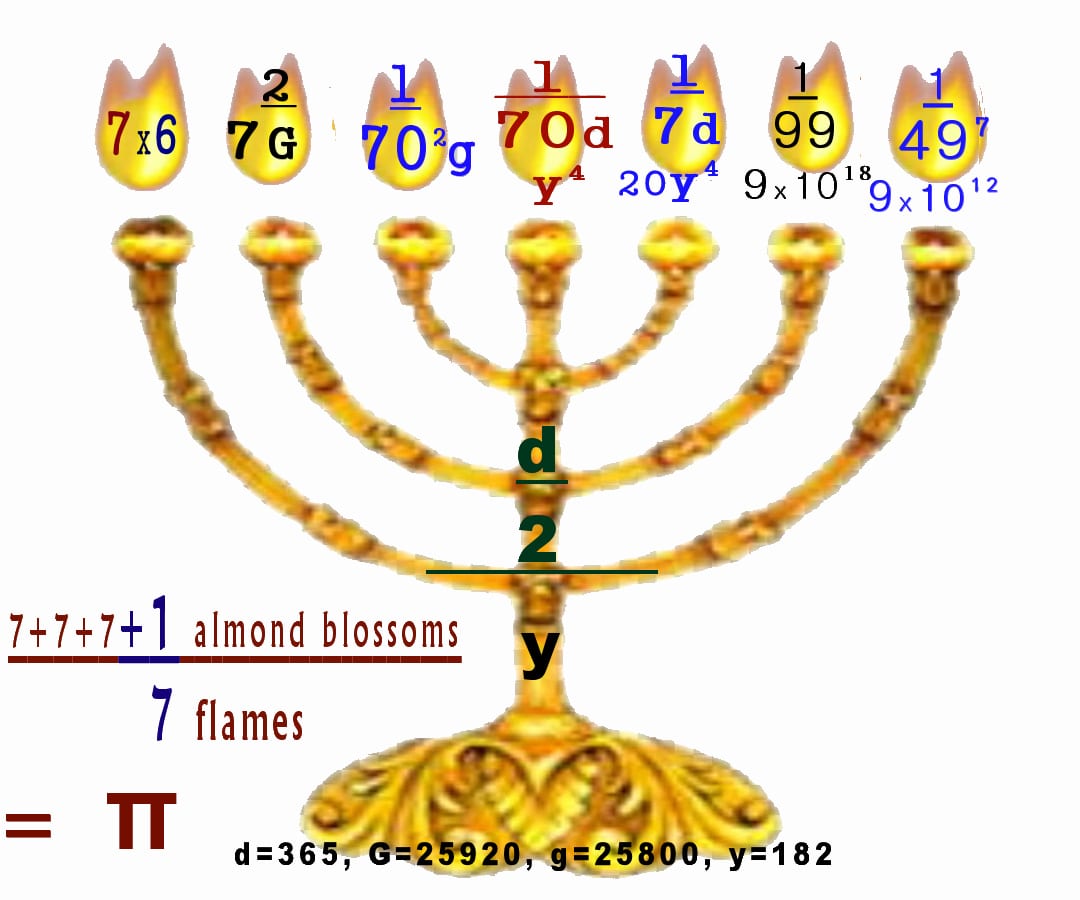
Pi is often simplified to just 22/7 and is unusually accurate for such a small fraction.
Why has God arranged pi so?
It’s because 22/7 explains the timing of all the Jewish feasts.
The above formula has a “week” for its denominator. It’s the lowest possible unit that creates the simplest formula for pi.
Pi is about space and time
When we think about pi, we think of a circle. We usually do not equate the circle with time but instead with space and distance. But when you think about it, natural clocks are based on the circle. The moon goes around the earth, the earth around the sun, the sun around the galaxy. Even the stars in relation to Precession form a small circuit.
Ho Ariel, Ariel, the city where David encamped! add ye year to year; let the feasts come round: (Isa 29:1 ASV)
Even the Bible refers to half-of-seven years as “a time, times and half a time”, (Rev 12:14). “A time” refers to one cycle of the sun as perceived from the earth.
The first term: “3w+1/w”
The denominator is one “week“
-
- The Bible often divides the week in half
- Likewise, Enoch’s calendar begins 3.5 days after the beginning of creation because this is when the sun, moon, and stars were made, and by this time and Jewish festivals are fixed
- Pi itself, expressed as 3.14 days, brings us to the 4th day of creation when God made the sun corresponding to the first day when He created light, which is the ratio of Pi (1:3.14…)
- Reduced to its smallest fraction, 3 weeks/1 week reduces to 3/1. (See Part Two)
- Creation is based upon this exact formula: 3 days of forming and three days of filling what was formed, each day in corresponding parallel
- God rested on the 7th day
- Hence the pattern of pi and creation is 3+3+1 = 7, and 3.5 + 3.5 = 7
The numerator is 21 + 1 (“3w + 1”)
-
- We do not know if Creation began in the spring or fall. The ambiguity is intentional
- If in spring, then one week after the first seven days of creation commences Passover week that lasts until the 21st of Nisan/Abib
- The 21st day is part of the formula
- Half-a-solar cycle later (or 3.5 cycles later) began Rosh Hashanah, the fall of New Year
- The Feast of Tabernacles lasts seven days, Tishri 15-21 inclusive. It corresponds to the seven days of Passover exactly six months earlier
- However, the 22nd day of Tishri was a special Sabbath. This day completes the full yearly cycle of all the previous three major and four minor feasts (seven feasts in all)
- This special 22nd day — the day that follows the seven days of Tabernacles is derived from the 22nd day of pi as found in the formula.
- Notice that all subsequent terms are included within this special 22nd day, which is the 8th day of Tabernacles and represents the eternal day of the New Creation
Why 49 days between Firstfruits of the Barley and Wheat harvests
Jesus rose from the dead on the festival of the firstfruits of the barley harvest (Nisan 16th), and the Holy Spirit was poured out on the celebration of the Wheat harvest 49 days later.
Hidden weeks in Pentecost
The symbolic meaning of numbers is hidden initially within the 360 calendar. As explained, this is true of both the Jewish and Enochian calendars.
From the Jewish New Year of Rosh Hashanah unto the 16th day of Firstfruits are six months and 16 days, (30 x 6 + 16 = 196 days). “196 days” is 49 x 4, plus the 49 days until Pentecost equals 49 x 5.
“49 days” is seven weeks (7 x 7 days).
“Seven times seven” in one form or another dominates the full formula.


Part Four: 6w/13w, “The Perfect Redemption of Fallen Man”
In part four we explore the next term in the formula: 6w/13w, “The Perfect Redemption of Fallen Man”.
What about the Day of Atonement on Tishri 10th? On the 360-calendar, a leap month of 30 days is inserted in the spring every six and 40 years, etc. Thus, the first jubilee when Israel entered the Promised Land had a leap-month on the 360 calendar, as does AD 2025, 70 jubilees later (70*7*7). This means that one can count 210 days to Rosh Hashanah, plus the additional 10 days to the Day of Atonement makes 220. Again we perceive pi, (ten-times) "21 + 1". Or, 220 days to when the lamb was set aside for Passover on Nisan 10th, the anniversary of when Israel crossed the Jordan into the Promised Land. Moreover, the Day of Atonement is the only special day recorded in the Bible that is said in the context of the previous half-year, (and subsequent half-year). It says this in regards to the "50th year" of the 49 years of Jubilee,(Lev. 25:1–4, 8–10). Moreover, the ten days leading up to the Day of Atonement are called the "Ten Days of Awe" and directly link Rosh Hoshanna with the Day of Atonement. Thus we have this solemn pattern, 30 days + 180 days + 10 days, that is, 210 + 10 = pi! This, plus another three years (1080) equals the 1290 days of affliction of Daniel 12, etc. Concerning the 70 days of the ratio of pi as 220:70, well, you can figure that out for yourelf at this link. Clue, (death of Moses) 220:70 (death of Aaron), and 70:210, whose deaths together bear witness to the all encompassing death of Christ, just like the two goats on the Day of Atonement, (Lev. 16:8; Deut 34:6; Jude 1:9).




Some interesting notes:
Matthew 16:18 (Caesarea Phi-lippi) The wonderful # PHI
And I say also unto thee, That thou art Peter, and upon this rock I will build my church; and the gates of hell shall not prevail against it. .
P=16 E-5 T=20 E=5 R=18 16X5X20X5X18=144,000
Caesarea Philippi, which stood in a lush area near the foot of Mount Hermon, was a city dominated by immoral activities and pagan worship. Caesarea Philippi stood only twenty-five miles from the religious communities of Galilee. But the city’s religious practices were vastly different from those of the nearby Jewish towns. In Old Test- times, the northeastern area of Israel became a center for Baal worship. In the nearby city of Dan, Israelite king Jeroboam built the high place that angered God and eventually led the Israelites to worship false gods. Eventually, worship of the baals was replaced
with worship of Greek fertility gods. Caesarea Philippi, which stood in a lush area near the foot of Mount Hermon, became the religious center for worship of the Greek god, Pan. The Greeks named the city Panias in his honor. Years later, when Romans conquered the territory, Herod Philip rebuilt the city and named it after himself. But Caesarea Philippi continued to focus on worship of Greek gods. In the cliff that stood above the city, local people built shrines and temples to Pan.
Interestingly, Jesus chose to deliver a sort of “graduation speech” to his disciples at Caesarea Philippi.In that pagan setting, he encouraged his disciples to build a church that would overcome the worst evils.
THE GATES OF HELL
To the pagan mind, the cave at Caesarea Philippi created a gate to the underworld, where fertility gods lived during the winter.They committed detestable acts to worship these false gods. Caesarea Philippi’s location was especially unique because it stood at the base of a cliff
where spring water flowed. At one time, the water ran directly from the mouth of a cave set in the bottom of the cliff.
The pagans of Jesus’ day commonly believed that their fertility gods lived in the underworld during the winter and returned to earth each spring. They saw water as a symbol of the underworld and thought that their gods traveled to and from that world through caves.
To the pagan mind, then, the cave and spring water at Caesarea Philippi created a gate to the underworld. They believed that their city was literally at the gates of the underworld—the gates of hell. In order to entice the return of their god, Pan, each year, the people of Caesarea Philippi engaged in horrible deeds, including prostitution and sexual interaction between humans and goats.
When Jesus brought his disciples to the area, they must have been shocked. Caesarea Philippi was like a red-light district in their world and devout Jews would have avoided any contact with the despicable acts committed there. It was a city of people eagerly knocking on the doors of hell.
Phi is the 21st letter of the Greek alphabet and in mathematics, it is used as a symbol for the golden ratio. The golden ratio refers to a special number that is approximately equal to 1.618. It is also known as the golden section, golden mean, divine section, medial proportion, golden cut, extreme and mean ratio, golden number or divine proportion.
These were just some notes from my studies on PHI
The math is getting easier to digest after so many years of studying the numbers …. Thank God!
So Amazing
Comprehension is usually proportionate to effort.
Glad that you persevered in your studies.